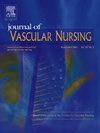Understanding adherence to guideline-recommended therapy in patients with peripheral artery disease: A qualitative study
IF 1.1
Q3 NURSING
引用次数: 0
Abstract
Objectives
Adherence to peripheral arterial disease (PAD) treatment remains low, despite its benefit for secondary disease prevention. Currently, there is no qualitative research exploring why this is the case. This study aimed to explore patients’ lived experiences of PAD and its treatment, their motivation to adherence and barriers to non-adherence.
Methods
Semi-structured qualitative interviews were conducted with patients with PAD from diverse backgrounds and varying adherence levels. The Perceptions and Practicalities Approach framed the topic guide and guided analysis. Interviews were recorded, transcribed verbatim, and analysed thematically. A public and patient involvement group supported the pilot testing of the topic guide and the data analysis.
Results
Twelve participants (eight men and four women, with an age range between 56 and 78) participated in the study. Six themes were identified: (1) Treatment necessity and effectiveness, (2) Information, (3) Mind-over-matter, (4) Concerns, (5) Physical environment, (6) Social and healthcare professional interactions. Patients perceiving their treatment to be effective were more likely to be adherent. However, some patients did not see themselves as being on treatment as they were not getting better. Participants expressed a lack of support and a need for detailed information and individualised care.
Conclusion
Our findings illustrate that patients’ perceptions of treatment effectiveness seem to influence their adherence. To enhance adherence, future research should focus on improving treatment understanding, optimising patient experiences, addressing claudication pain management, and supporting patients to be more motivated to make changes.
了解外周动脉疾病患者对指南推荐治疗的依从性:一项定性研究
目的外周动脉疾病(PAD)治疗的依从性仍然很低,尽管它对继发性疾病的预防有好处。目前,尚无定性研究探究其原因。本研究旨在探讨PAD患者的生活经历及其治疗,他们坚持的动机和不坚持的障碍。方法采用半结构化定性访谈法,对不同背景、不同依从程度的PAD患者进行访谈。感知和实用性方法构建了主题指南和指导性分析。采访被记录下来,逐字抄录,并按主题进行分析。公众和患者参与小组支持主题指南的试点测试和数据分析。结果12名参与者(8男4女,年龄在56岁到78岁之间)参加了这项研究。确定了六个主题:(1)治疗的必要性和有效性,(2)信息,(3)心灵高于物质,(4)关注,(5)物理环境,(6)社会和医疗保健专业人员的互动。认为治疗有效的患者更有可能坚持治疗。然而,一些患者并不认为自己在接受治疗,因为他们并没有好转。参与者表示缺乏支持,需要详细的信息和个性化的护理。结论患者对治疗效果的认知影响其依从性。为了提高依从性,未来的研究应侧重于提高对治疗的理解,优化患者体验,解决跛行疼痛管理问题,并支持患者更有动力做出改变。
本文章由计算机程序翻译,如有差异,请以英文原文为准。
求助全文
约1分钟内获得全文
求助全文
来源期刊

Journal of Vascular Nursing
NURSING-
CiteScore
1.40
自引率
0.00%
发文量
33
期刊介绍:
Journal of Vascular Nursing provides clinical information regarding aortic and peripheral aneurysms, upper and lower extremity arterial disease, acute and chronic venous disease, and more. Original, peer-reviewed articles present descriptions, etiologies, diagnostic procedures, medical and surgical treatment and nursing implications of vascular system disorders.
 求助内容:
求助内容: 应助结果提醒方式:
应助结果提醒方式:


